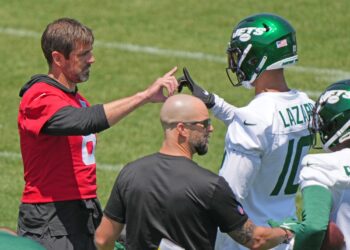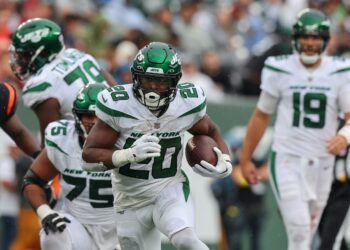Inside The Numbers: Can The NY Jets Release Holmes And Scott?
Following a late season collapse many fans of the New York Jets started to demand personnel changes including the release of wide receiver Santonio Holmes and linebacker Bart Scott. Recently Jason Fitzgerald of NYJETSCAP.com took the time to talk about the feasibility of moving these two veteran players and answered some additional Jets salary cap/contract questions as well. For those of you that are not familiar with Jason’s site it is arguably the most informative New York Jets site on the internet when it comes to Gang Green’s salary cap and player contracts.
TR: Many fans have been calling for the Jets to release wide receiver Santonio Holmes. What are the Jets options with Santonio as he signed a hefty contract prior to the 2011 season?
JF: If the Jets plan on releasing Holmes they have to act quickly and do it as soon as allowed by league rules. If Holmes remains on the roster a few days beyond the beginning of the waiver period in mid February he will guarantee an additional $7.5 million in salary in his contract. Holmes is due $7.75 million in guaranteed pay from the Jets in 2012, but that money would likely be fully offset when he signs with another team. What that means is that Holmes can’t “double dip” by earning salary from his new team and old team at the same time. The Jets would incur $12.75 million in dead cap if they release Holmes before being credited for whatever Holmes earns with a new team. If Holmes is on the roster in late February it is safe to say he will not be released this season.
The safest option is to find a trade partner who would be on the hook for Holmes’ guarantees. That would only cost the Jets $5 million in dead cap charges, which is less than Holmes’ 2012 cap charge.
TR: There were some rumblings that the Jets were going to release linebacker Bart Scott. What would be the cap hit if Gang Green did indeed cut Scott?
JF: The Jets fully guaranteed Scott’s 2012 salary in return for his acceptance of a paycut of $2.4 million, so they are on the hook for $4.2 million in 2012 salary plus another $3 million in dead cap charges if they were to cut him, a total of $7.2 million. Like with Holmes, the Jets would get a credit for money Scott earns elsewhere, but unlike Holmes it is hard to envision much of a market for a 32- year old ILB that was pulled in passing situations last season. Scott’s cap charge to remain on the team is $5.95 million. I would think that makes it likely that he stays on the team, at least until the NFL draft when the Jets could pick up his replacement. Even then I picture Scott more as a potential late preseason cut than a player cut in late April.
TR: Based on the information that you have gathered what is the Jets cap # for 2012? Are there any players that could be on the chopping block due to their price tag?
JF: Right now the Jets have about $123 million in cap commitments for 2012, a number that does not include some performance bonuses which could increase that total to around $128 million if they were earned. The Jets will also carry over a cap credit of about $8 million so their estimated cap space will be anywhere from $0 to about $5 million.
The player most likely to be cut is Wayne Hunter, which provides $2.5 million in cap savings. I would say a very outside chance of Mike DeVito being released if he looks to have lingering effects from his injury and a possibility of exploring a trade for TE Dustin Keller who may not block well enough for their new offensive scheme. Both are players who may have earned hefty bonuses.
Most likely the Jets will obtain cap relief by renegotiating the contracts of players on the team. Safety Eric Smith will need to take a paycut and would should save the team about $1.4 million. QB Mark Sanchez has a $14.3 million cap charge, which should be reduced by at least $5 million this year. Mark needs to take a paycut with a chance to earn his salary back as there is no way to justify his current cap charges. LT D’Brickashaw Ferguson can easily give the Jets $4-$5 million in cap relief by simply restructuring his contract.
TR: Sione Pouha, a player that I believe is the Jets best defensive lineman, is slated to become an unrestricted free agent. What type of contract can you see Sione getting?
JF: The one thing people forget about Pouha is that he is already 33 years old. Despite not having a ton of “football miles” on his tires, it is hard for most people, let along people as big as Pouha, to not begin to physically break down. The Jets ran him into the ground this season changing his role from that of a rotation player to a every down player and that can have a big effect on a guy.
Most players his age get 2 or 3- year contracts. He is better than most of them so I would think the ballpark is 3 years around $14 million. My assumption would be if he gets a much higher offer the Jets will likely let him walk. Pouha can also be franchised for somewhere around $6.5 million, which could be an option if they want him for one more season but do not want a longer term commitment.
TR: One of the biggest surprises for the Jets in 2011 was linebacker Aaron Maybin. Maybin is scheduled to become a restricted free agent. If the Jets were to try and extend Maybin what type of contract can you see him getting?
JF: I don’t think either side wants to extend Maybin right now. He is the definition of a situational pass rusher and there are few, if any, comparable players to look at for a contract. At the beginning of the year he was done with the NFL because there was no interest in him and you want to see if last year was real or a fluke before even entertaining a small contract. On his end he has the draft pedigree to earn big money if he can be a full time player that gets double digit sacks. He will be tagged at $1.2 million next season and play under that tag.
TR: Many members of the media continue to stir up the Peyton Manning to the Jets story. While I think there is zero chance of this happening, do you think Indianapolis can trade Peyton?
JF: I think the trade window has passed for the Colts. A player cannot be traded until the official start of the 2012 league year and Manning has a $28 million dollar option that must be picked up before the start of the 2012 league year, thus forcing the Colts to pay him $28 million to play somewhere else. The belief was that the Colts and Manning would simply change the date of the option and make the acquiring team responsible for the option bonus. However, under the rules of the CBA, contracts for the 2011 league year can’t be renegotiated after the final regular season game and at this point any change to Manning’s option bonus date would represent a change to his 2011 cap figure, which makes it against the collectively bargained rules. So the Colts options, in my opinion, are to release Manning or to keep him next season.
TR: Jason, once again thank you again for your time and all of this valuable information. I strongly recommend that everyone checks out NYJETSCAP.com.
Videos
News and Notes from First Two Days of Jets Training Camp









